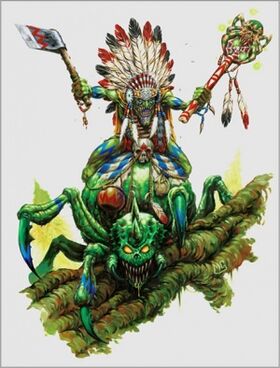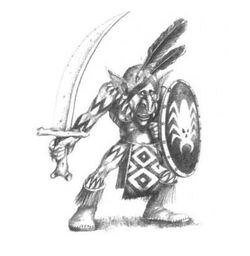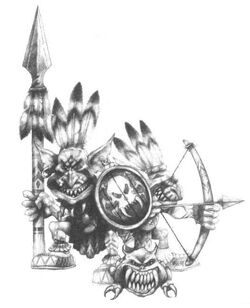"They were already over the walls before the guards knew they were there. The town was destroyed and half the population was carried off to the forest..."
- —Albrecht Heinz, Drakwald Militia.[3e]

A Forest Goblin Shaman.
Forest Goblins are a culture of Goblins that live in the deep, dark forests of the Old World and worship spiders. They are infamous for their lightning raids and their terrifying appearance, as they decorate themselves with brightly coloured feathers, bits of bone, and warpaint.[1a][1b][1d][3b][3e]
Appearance

Forest Goblin warrior, by John Blanche.
Forest Goblins are not physically different from other Goblins. They are the same size, have the same green skin, and overall it would be hard to tell one from another were it not for their distinctive styles of dress and skin painting.[1b] They represent a cultural adaptation to the lands they live in, much like the fur-clad Wolf Riders of the plains, and they're not a different breed of Goblinoid.[3a]
Forest Goblins decorate themselves with colourful feathers, often sticking the quills directly into their skin as Goblins feel little pain. Different tribes often use different colours and combinations of feathers to identify themselves.[1b][3c]
Metal ores are quite rare in the forests, so the Forest Goblins trade with other Goblin tribes, swapping captives and fungus for ores from the mountains. Because they don't have much metal at their disposal, Forest Goblins also like to use bones and teeth to make armour as well as for decoration.[1b]
Forest Goblins wear warpaint in broad bands of colour over their bodies. Bright red and blue are the most popular colours, and these are commonly applied to make V-shaped chevrons over their face and arms.[1b]
This combination of brightly coloured feathers, bits of bone, and warpaint adds to their frightening appearance when they emerge from the forests to carry out raids on surrounding villages and farms.[1a] Furthermore, when they charge, the Forest Goblins are well known for screaming out their horrible, high-pitched and undulating battle cries.[3e]
Shields and banners often have spiders on them, and spider decorations are common designs for buckles, banner pole tops, and weapons.[1b]
History
Origins
Since Goblins first entered the primeval woods, they have been prey to the spiders that dwelt within the arboreal confines. The goblinoids adapted their customs to the woodland environment, becoming the precursors of the Forest Goblin tribes known today.[3f]
They soon found that packs of Giant Spiders could be defeated and, over time, could even serve as mounts. The larger Gigantic Spiders could be fended off and, if their broodlings were captured, these could be hand-fed and turned into great steeds for powerful leaders.[3f]
In time, the Forest Goblins became experts when it came to capturing and finding uses for these creatures. Forest Goblins even eat certain species of spiders which they regard as especially succulent and superior to any other kind of flesh[1b], while others are milked for poisons,[3e] or kept as pets.[1b][3e]
Rise of the Spider-kult

Forest Goblin spearman and archer, by Wayne Englands.
However, no tribe could stem the onslaught of the rare Arachnarok Spider, whose appearance spelt a horrible end for an entire tribe or, at the best, a rapid move of camp with many a fearful backwards look.[3f]
The Goblins reasoned that since the powerful arachnids could not be defeated, perhaps they could be appeased. Eight-legged totems festooned with webbed skills began to appear alongside the traditional idols of Gork and Mork. The Forest Goblin Shamans, having recently discovered the hallucinogenic venom of the tinier spiders, talked about the many-faceted eyes of the Feaster from Beyond. With tongues swollen purple from the bites of tiny mouth-mites, the Shamans turned to worshiping the Spider-god.[3f]
The tribes followed their Shamans in supplicating themselves, and the Spider-kult was born. Although Gork and Mork were not forsaken, in the black thickets of the endless forest the Spider-god soon ruled supreme. Forest Goblin Shamans led gruesome rituals, and the tribes offered elaborate sacrifices.[3f] The tribes raised totem poles depicting Gork, Mork and the Spider, and this is where they meet before marching to raid a human farmstead or burn some woodcutter's house.[1b]
For some reason, the eight-legged behemoths did not attack Forest Goblin camps surrounded by Spider-totems. Some crept to the edge of the fire-lit clearings to watch the tribes weave the spider-dance and offer gifts of warm blood to the insatiably hungry Kings of Spiders. Emboldened, some Shamans dared approach their living idols. Many tried to communicate and were summarily eaten, until finally the mystical properties of the small Purple Skullback spiders were discovered.[3f]
By chewing on enough of the bulbous, plum-coloured savouries, a Shaman either died a twitching and horrible death or entered such a state of shock that new vistas and mindpaths into the Great Beyond were opened. The convulsive rhythms of a mind-numbed Forest Goblin Shaman will entrance an Arachnarok. The great spider will sway back and forth on hunched legs, the image of the tiny twitching gobbo reflected in the black orbs of its many eyes. Under the hypnotic spell, the Shamans discovered they could communicate in simple terms with an Arachnarok.[3f]
The ravenous depredations of the Arachnarok were ended and Forest Goblin Shamans learned that, with enough bribes of fresh blood, they could call out to such a beast. Instead of fleeing from the deepwood behemoths, Forest Goblin tribes began to purposefully seek out and encamp near an Arachnarok's lair. There the tribe proffered the beast sacrifices and used Shamans to coax the enormous spiders out should a formidable enemy draw near.[3f]
The worshipped spiders grew even more bloated due to the non-stop supply of blood-rich offerings. Many spiders began to remain in their darksome holes as still-screaming food was thrown into their pits. Over long periods of time some Arachnarok Spiders no longer needed the shamanistic rituals, having grown tolerant of Forest Goblins and even allowing them to scurry about their hulking bodies to build great stick-howdahs from which to shoot.[3f]
Current Distribution
Nowadays Forest Goblin tribes are to be found in the depths of many wooded areas, but most are concentrated in a wide forested belt south of the Empire, stretching the length of the Border Princes from Black Fire Pass in the east to Tilea in the west.[2a]
Nevertheless, their most sacred abode is the Black Pit, also called the Valley of Many Eyes, in the depths of the Drakwald Forest - it is the breeding grounds for the largest of spiders, and it is a death sentence to pass the web-covered spider-totems that mark its boundaries.[3c]
War of the Drakwald
In 2518 IC[3d], when men from the Empire first cut their frontiers deeper into the surrounding forest, they unwittingly began the bitter War of the Drakwald that continues to this day. The fractious Forest Goblins who dwelt in the hinter regions of that sprawling woodland ceased their internal strife to unite against the enemy. Unbeknownst to the men of the Empire, their deepest forays had encroached dangerously close to the most holy of sites to the Forest Goblin tribes, the sacred lands known as the Black Pit. To stray near that dark and web-strewn place is certain death, for the Forest Goblins will stop at nothing to destroy any interlopers who dare approach it.[3g]
At first, forest patrols and huntsmen disappeared at an alarming rate. The deep woods were always treacherous, but the men of the Empire were savvy enough about life beneath the boughs to understand that something terrible was brewing. They didn't have to wait long, for soon the Forest Goblin raiding parties mobbed together to form armies. Emboldened by their numbers, the Forest Goblins left the confines of the woods to mount fierce attacks on the nearest human settlements. In turn, fresh troops marched out from the Empire's cities, eager to push the boundaries of civilisation further. Many ambushes and large battles followed, most fought entirely beneath the gloomy canopy.[3g]
Early in the battles in the Drakwald, the Empire soldiery cleared first the lands of the Gnarlwood, destroying the Redvenom tribe and blasting their Arachnarok Spider with cannon shots. The tribe's only known survivor, Snagla Grobspit, would become one of the rising legends amongst the Forest Goblins during this period. He and his mob of Spider Riders, the Deff Creepers, were at the forefront of every greenskin victory. It was Snagla who rode straight into the line of Handgunners and broke the Empire's flank, leading to what is now known as the Forest Road Massacre, and it was the stealthy Deff Creepers who silenced the central watchtower of the walled town of Glomstadt, leading to its fall. His foes whisper that Snagla and his Spider Riders can creep right out of the very shadows, and perhaps it is true.[3g]
Wargear
Forest Goblin warriors wear exotic war paint, carry war axes and are often decorated with colourful feathers. Each is usually armed with a one-handed war axe or club and can also carry a shield, spear, short bow and/or a two-handed weapon.[1d]
Miniatures
(Note: The miniatures released for the Spider Riders, the Arachnarok Spider, the Forest Goblin Shaman and the Forest Goblin Warboss are included in their respective articles.)



